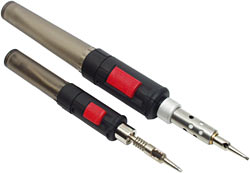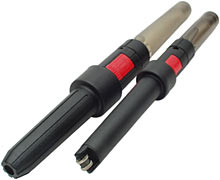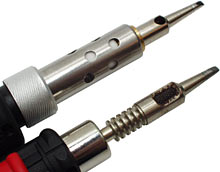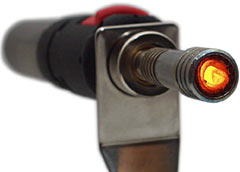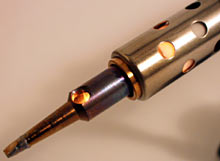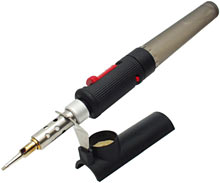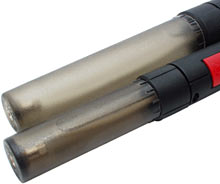
Vulkan P100K and P200K gas soldering iron kits
Review date: 5 February 2002. Last modified 03-Dec-2011.
If you don't know how to solder, you're not a hardware hacker. And in order to solder, you need a soldering iron. Stop me if I'm going too fast for you, here.
Most of the world's electronics soldering irons are electric; you plug them into the wall. You can get super-cheap electric irons that're quite good enough for most people's purposes, and you can get fancy electric soldering stations too - of which more shortly.
All mains powered irons, though, have a cable dangling from them. This is somewhat awkward all of the time, and can be very awkward when you're squishing yourself into some weird position to reach the wire lugs on the aft facet of a supramitive wennelsprock.
And, of course, if you don't have electricity, you can't use an electric iron.
Even big electronics irons are pretty low power devices by appliance standards, so you can run them from a modestly powerful inverter if you're out in the boonies with a 12 volt battery. And an inverter. There are purpose-made 12 volt irons, too, with supply leads that terminate in alligator clips or a car cigarette lighter plug; you can run them for hours from a fully charged car battery. Or, indeed, from a computer PSU, if you're feeling kinky.
If there's no electricity to be had at all, though, then you need a self-powered iron of some sort.
Battery powered cordless electric soldering irons exist, but they're pretty low powered, don't have much battery life, don't work well when the battery's going flat, and take a while to charge.
A much better solution, since all you need is heat, is to burn fuel to get it. Plain old "butane" lighter gas (see the box to the right for why there are quotes around "butane", there), available all over the place, has energy density (amount of energy per unit weight and volume) that rechargeable batteries can only dream of. And basing a soldering iron around a gas burner lets it do things that electric irons can't, like work as a hot blow gun or a blowtorch.
Gas irons have impressive run time per fill, cost little to run (more than an electric iron, but not enough more that it matters), can be refilled in seconds, and work at pretty much full capacity until they're almost completely empty. I like 'em. I use 'em all the time.
And, for some reason, two companies making really good ones are both based in Carlow, Ireland.
One of the companies is Oglesby and Butler, who make Portasol brand irons, like the one I reviewed a couple of years ago here. The other company is B.S. Manufacturing, who make Vulkan Gas Tools.
B.S. Manufacturing were good enough to send me these - their P100K and P200K gas iron kits.
The actual irons that these kits are built around are the P100 (the little one) and the P200 (the big one). They're available by themselves with minimal accessories, or in the fancy kits with the nice boxes and some extras.
Here in Australia, you could get both the plain irons and the full kits from Jaycar Electronics, when I first wrote this review; now, they only seem to be selling a couple of P100 kits, but they still have bits available for both irons. The irons are distributed in this country by Electus Distribution, which is a Jaycar offshoot.
The retail price for the plain P100 from Jaycar is $AU49.95; for that you get the iron complete with safety cap and a 2.4mm soldering tip. The P100K kit is $AU89.95, and adds some more stuff, pretty pictures of which will follow in a moment.
The P200 was $AU99 from Jaycar, when they sold it; it comes with a 2.4mm soldering tip, hot air tip, cap, and a stand with sponge, so it's not really an iron-only deal. The P200K full kit was $AU129.
These prices are pretty good, compared with the Portasol competition. The giant Portasol PS-100K is much like the Vulkan P200, and it's sold in a similar kit to the P200K by Dick Smith Electronics for a hefty $AU159. They also sell a Weller-branded Portasol that's much like the P100K, for $AU94. The old orange spark-light Portasol, which has bounced around the toolboxes of countless field circus operatives for years now, is $AU50, but the Vulkan P100 is a much newer and rather better product.
The P100K kit gives you this selection of tips for the iron. From left to right, you're looking at the 2.4mm soldering tip (the iron's good for power output of about 20 to about 100 watts; you adjust the gas flow with a sliding tab on the side), the hot blow tip (very handy for shrinking heat-shrink tubing, great quantities of which all good wire-splicers should own), the blowtorch tip, and the hot knife tip, which is useful for cutting and fray-proofing plastic rope, and for making quick (and often smelly) cuts in various other meltable materials. You can melt things with ordinary soldering tips as well, of course, but if you do then you're likely to wreck the tinning on the tip, so it won't take solder properly afterwards.
In the foreground of the above picture is the "collet" into which all of the tips screw. The collet itself screws into the body of the iron, and it's a minor weak point of the P100. The standard right-hand threads on each end of the thing mean that it's possible for the tip thread to stick, especially when it's hot, and make it difficult to change tips without holding the collet with one pair of pliers and the tip with another. Out of the box, the tip thread of the P100 I got for review was firmly seized.
Once you know about this, though, it's an easy enough issue to deal with. A dab of some heatproof lubricant or other - like a puff of graphite powder, for instance - on the sticky thread ought to solve the problem.
Here are the tips that come with the P200K kit. From the left, there's the retainer surround that you use with every tip, another 2.4mm soldering tip (the colourful oxidation happens the first time you get the tip really hot; with a 20 to 130 watt power rating, that's not hard), a hot blow tip, and a hot knife.
You change tips on the P200 the same way as you do with the Portasol PS-100K; you unscrew the collar at the bottom of the retainer, drop the tip out of the retaining assembly, drop a new tip in, and reassemble. As with the PS-100K, if you assemble the P200 with no tip at all, it's in blowtorch mode.
Here are the irons with their protective caps on. You can put on the caps while a tip is still hot. Putting the cap on either iron pushes the gas-flow slide switch on the side into the off position; this is a standard feature of all half-decent butane irons, since it's been experimentally proven to significantly reduce the number of toolboxes that burst into flames.
The P200 cap is just a tapered sheath with a heat-releasing hole in the end. The P100 cap has a flint sparker in the end of it. It's there because that's how you light the P100 - either by sparking at it, or by applying a flame. All of the P100 tips are therefore open, or have a large-ish mesh aperture on one side, to allow you to light them. Lighting them with a sparker can take a few attempts, depending on the tip; lighting with a flame is easy, but you do have to have a flame to hand. Both kinds of lighting are a two-handed operation.
The P200, like other classy gas irons, has piezoelectric ignition, which works the same way as it does in Portasol's fancier irons. The gas switch pushes up to work the sparker, with a spring to return it to the standard gas-on position. Piezo ignition can be done one-handed; it's a lot more elegant than spark/flame ignition, and it also allows the P200's tips to be more enclosed, and thus harder to damage, than the P100's.
I believe the P200's tips to have superior funkitude to the P100's. Your opinion may differ.
Then again, this is the P100's hot blow tip, which leaves you in no doubt about its hotness. The glowing thing in there is something that's also inside every other non-blowtorch gas iron tip; it's a platinum catalyst that allows the gas to combust without a flame. These irons all do burn with a flame initially; the P100's soldering tip can actually burn away through the exhaust port for quite a while if you light it with the sparker, which is a problem that the spark-light Portasols have too. Once the catalyst gets hot, though, it takes over and starts glowing brightly, and the naked flame goes out.
Light the P100's soldering tip with a flame and you can heat the catalyst more effectively; the P100 hot blow tip has the catalyst right out there with no grille in the way, so it gets going very quickly even if spark-lit. The P200's internal ignition puts the flame behind the catalyst, contained within the tip, so it gets itself started in less than a second every time.
Gas iron hot blow tips, by the way, aren't a substitute for a proper heat gun. Heat guns are those things that look rather like a hair-drier, but generally have a prominent warning printed on them that says that only people who want to end up looking like an instructional illustration from a 1950s Civil Defense pamphlet with the caption "What Will Happen To You If You Don't Duck And Cover" should actually use them as a hair-drier.
Gas iron hot blow attachments blow gas that's more than sufficiently hot to strip paint, soften putty and do those other heat gun tasks, but they don't blow nearly enough of that hot air to be practical for most jobs of this sort. When you consider the hundred-watt-ish power rating of a gas iron going full blast, and the 1500-watt-ish rating of a cheap electric heat gun, it's pretty clear who's going to win.
The P200 can compete with the P100 in the glow stakes. Here it is with its ceramic air/gas mixer and its tip's catalyst glowing away cheerfully.
Note that all gas iron tips that don't have a hot-blow or flame hole in the end will have an exhaust port in the side, because the combustion products have to go somewhere. This is good, because it means that any tip can be used as a quick and dirty hot blow tip. But it's bad, because it means that your soldering iron is always blowing burning hot gas out of the side of the tip, with which you can scald yourself or the thing you're working on. Or your table, if you put the iron in its stand with the port facing down and the power turned up.
You thus have to maintain a bit more situational awareness when using a gas iron than when using an electric one. Just remembering not to pick it up by the hot end is not sufficient.
Both Vulkan kits come with these two value-adds - a three-by-one-inch rectangular trough containing a Magic Expanding Tip-Cleaning Sponge (it fills the trough when you wet it), and a little "hobby pack" of 1mm resin core solder.
With both kits, and with the no-box P200 as well, you also get this rather good stand, which is quite stable and sturdy and contains another tip sponge. Portasol's stands are just little wire things that you stick into the side of the iron storage box; they're not rubbish, but they're a bit awkward.
Both Vulkan irons have translucent gas reservoirs, which make it obvious when you're running out of fuel. Portasol's irons have little windows in the bottom, which don't make anything very obvious.
The P100's gas capacity is sufficient for about an hour of use, unless you're using full power all the time, which you probably won't be. The P200 is rated for up to 180 minutes, at low power; a couple of hours seems likely to be easily attainable.
Refilling either iron with any standard multi-tip lighter gas can takes only a few seconds, and you'll get several fills out of a can of gas that costs a few bucks. Jaycar sells 150 gram gas cans for $AU5.95; if you're caught short, hardware stores and tobacconists will sell you the same thing for a bit more.
Using them
In use, the P100 is much the same as a spark-light Portasol, and the P200 is much like my PS-100K. The side-mounted power controls on the Vulkan irons are a bit smoother and easier to reach than Portasol's twist-the-end flow control, and the P200's easier to manoeuvre than the bigger and bulkier PS-100K, but they're really pretty much interchangeable.
Which is high praise, because the Portasol irons are excellent tools, and the Vulkan irons cost less. And have that neat see-through gas reservoir, and a better stand, too. The only thing lacking is a heat shield for the hot blow tips, to stop the hot air from blowing past the thing you want to heat and barbecuing other stuff. The Portasol PS-100K comes with a heat shield; one for the P200 exists, but it's an $AU12.95 option.
The two irons in blowtorch mode, not quite to scale.
The P200K's blowtorch mode (on the left) is reasonably windproof; if you blow down into it then it's quite easy to extinguish, but blowing across it has much less effect. The P100K's blowtorch flame (on the right) is a bit more fragile, but not much.
Neither of these irons has the useless blows-itself-out-without-help needle flame that you get from a lot of poorly designed cheap irons.
If you find yourself having to braze-solder some relatively small object in the great outdoors, or if you want to light a camp fire, both of these irons can do it.
Both of the Vulkans, like every other gas iron I've used, burp gas a bit when they're really full and can, in extreme cases, blow themselves out. It's easy enough to avoid this by just not filling them absolutely as far as you can, though.
Why wouldn't you want one of these? Well, the limitations of the Vulkan irons are the limitations of every butane iron. Apart from the hot-exhaust-port issue, they also have no fine temperature control.
Butane irons have a wide range of available power settings and, thus, operating temperatures, but they don't have fine control, or any way to tell exactly what temperature they're at, at any given moment. They'll tend to run a bit hotter at a given setting when they've just been filled, and the gas flow will be higher when the gas reservoir is warmer, but they manage a pretty even power level at a given setting. What that power level actually is, though, is hard to guess.
If a steady amount of heat's being extracted from the tip then it'll stay at one temperature, but that's not what real soldering is like - sometimes the tip has to melt solder, sometimes the tip's cooled a bit by a cleaning sponge, often it's just sitting there in the air. So you don't know what the temperature is, and it can also vary considerably.
For a lot of soldering, this doesn't matter at all. All you need is a tip that's hot enough to melt solder as fast as you're going to be squishing it in there; the shape of the tip is more important than the amount of heating power behind it. You want a fine tip for fine soldering, a fatter one for soldering heavier wires, and more specialised wider tips for unusual jobs like soldering wires onto rechargeable batteries. The 2.4mm chisel tips that come with the Vulkans are good for most work, and different sized angle and chisel tips are available separately - from Jaycar, P200 tips are $AU19.95, and P100 tips are $AU17.95.
For some soldering, though, better temperature regulation than a butane iron can deliver is helpful. Fine electronics work, in particular; for that, you want a well-regulated iron that stays hot enough to melt solder effectively, but doesn't get much warmer. Uneven heat will make the solder behave inconsistently, and too much heat can fry sensitive components.
If your iron is much too hot, it can also de-bond tracks from circuit boards and cause them to lift off, which is really annoying. A too-hot iron will also kill its tip faster than it would if it were cooler; high heat accelerates oxidation. And overheating your solder can give you a lousy joint for two reasons - one, you'll boil the flux out of your flux-core solder before you have time to make a joint with the stuff, and two, super-hot solder will stay liquid for an annoyingly long time and solidify more slowly, which can give you a joint with internal fractures, or let the component settle into the wrong position. Especially if the component is being held in the correct position by your Mark One Hand, and you burn yourself on the overheated wire before the solder's solid.
Realistically, most of these problems can be dealt with by just using a low heat setting on a gas iron. By all means, run it at full power for the first ten seconds, to get it to soldering temperature quickly - but then wind the gas flow back.
Really even soldering performance, though, needs better regulation than any gas iron can manage.
The full-blown temperature controlled soldering solution is a "soldering station", an electric iron rig with a base unit that contains a transformer and control circuitry, connected to a low voltage iron whose tip contains a thermal sensor. You dial up the temperature you want on the base unit, and the iron does its best to hold that temperature no matter what you're doing with it.
The cheaper version of this idea is an ordinary iron whose tip has its own little thermal regulator built in, and holds to one non-changeable temperature all the time. There are hybrids, as well - single-temperature soldering stations, and "stationless" irons with a little control on the side that lets you change the temperature at which they run. Most of these options will do better than a gas iron for fine circuit board work; tips for electric irons are cheaper than gas iron tips, too, and last at least as long.
For flexibility, though, you can't beat a gas iron. Soldering stations with hundred-watt-plus output are few and far between; you have to buy a big fat plumber's iron to get that much power from an electric.
With a gas iron, it's not a problem; you can solder a 1/8th watt resistor or a car battery cable, and in a pinch you can even do both jobs with the same tip.
The gas iron isn't likely to be quite as good for any job as an electric iron tuned to that one task, but the gas iron is small and neat and cordless and always ready to go, and it can work as a little blowtorch and hot blow gun and hot knife, too.
Overall
As I said, I like these irons. I wouldn't throw away a Portasol to stampede off and buy an equivalent Vulkan, but the Vulkan irons seem to be just as good as the similar Portasol models, with a couple of nice extra features, and a lower price tag.
Recommended.

